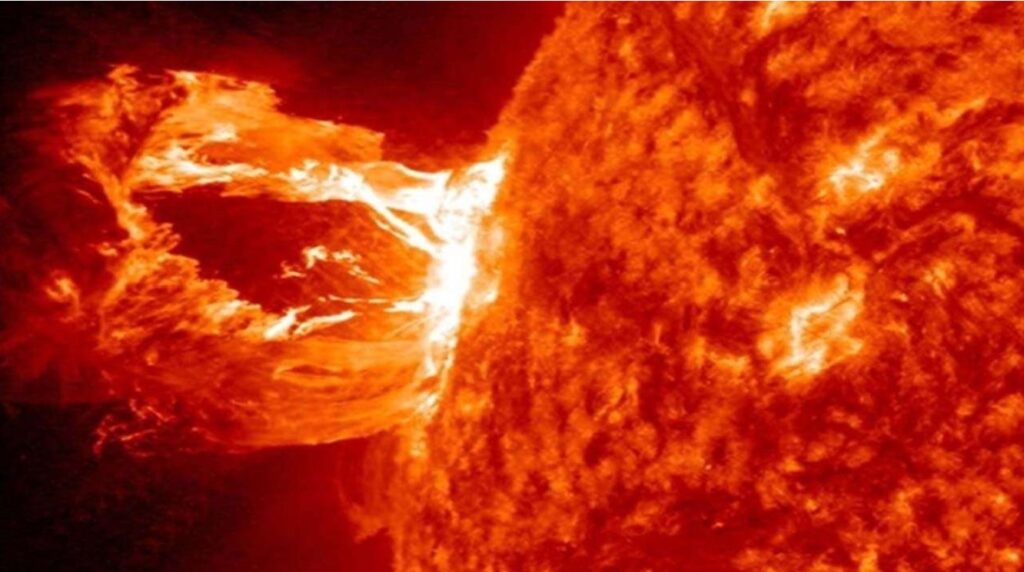This guest post was written by Neha Krishnakumar, an undergraduate at the University of California, Los Angeles. Neha is currently a first-year philosophy and communications major, taking a course on science journalism and astrobiology.

Paper Title: Where are Solar storm-induced whale strandings more likely to occur?
Authors: Klaus Heinrich Vanselow
First Author’s Institution: University of Kiel, Germany
Status: published in International Journal of Astrobiology [open access]
Our sun is a constantly active environment that can affect life all the way here on Earth. Solar storms are space weather effects on Earth that are caused by activity in the sun (NOAA 2022). This activity can send charged solar particles from the sun into the Earth’s atmosphere, in the form of a solar flare (NOAA 2022). Specifically, these particles tend to be more pervasive near the Earth’s north and south poles.
These solar storms can cause issues for biology on Earth, however. For example, they can cause an increase in whale strandings. Whale strandings occur when a whale, or group of whales, loses a sense of direction during migration. Instead, they wash up on a beach and are unable to return to the water (International Whaling Commission 2013).
Today’s article tries to understand where Solar storm-caused whale strandings are most likely to occur.

In the past, research has been done on whale strandings in the North Sea area. This data suggests that the magnetic activity from solar storms confuses the whales, and could be a reason that migration was changed. Basically, the authors of previous studies hypothesized that solar storms could be causing changes in the Earth’s magnetic field, creating difficulties when whales tried to navigate. To understand if this was the case, the authors of this article gathered data about the Earth’s magnetic field from several observatories (the World Data Center for Geomagnetism, the International Real-time Magnetic Observatory Network, and the Tromso Geophysical Observatory website), and inclination values from the National Centers for Environmental Information of the NOAA website (Vanselow 2020).
They explored the “geographical and geomagnetic coordinates of possible whale stranding sites in 2016” (Vanselow 2020). Then, they compared these locations to the magnetic field distortions and inclination during a specific geomagnetic storm. Lastly, they also considered the changes in the magnetic field and inclination over a span of 316 years. Overall, this analysis was coupled with the locations of whale strandings to find overlaps and points of interest.

Photo credit: World Whale Day
Based on their data analysis, the authors determined that the effects of solar storms on whale migration depend on the location since certain places have a geomagnetic field more affected than others. There are places like the southern Norwegian Sea and the southbound North Sea that are especially affected by solar storms and therefore see more whale strandings for species like sperm whales that pass by on their migratory paths.
The main thing to keep in mind from this paper is that whale strandings are often increased in places that are especially affected by the geomagnetic effects of solar storms, such as the north and south poles. This is important because awareness of these locations can help us guide or redirect whales past this area, or help us be more aware of where and when whale strandings are more likely to occur.
Why is beaching a serious problem in the first place? It can cause the loss of massive amounts of sea life – whales, dolphins, and similar creatures (International Whaling Commission 2013). If these strandings increase, they can seriously disrupt the ocean ecosystem and even lead to the extinction of certain cetaceans. In order to preserve the well-being of the ocean ecosystem, the author recommends more in-depth studies of whale navigation and strandings in order to effectively connect them to the occurrences of geomagnetic changes. It is unclear if these geomagnetic changes are the definite cause of increased whale strandings, but they definitely view them as a potential factor. By exploring this field further, we can really work towards developing sustainable solutions to prevent solar storm-induced whale strandings from occurring and protect these valuable species from beachings.
Edited by Jessie Thwaites
Featured image credit: https://nationaltoday.com/world-whale-day/
Works Cited
IWC. “Strandings.” International Whaling Commission, 2013, https://iwc.int/management-and-conservation/strandings. Accessed 16 April 2022.
NOAA. “Solar Radiation Storm | NOAA / NWS Space Weather Prediction Center.” Space Weather Prediction Center, 2022, https://www.swpc.noaa.gov/phenomena/solar-radiation-storm. Accessed 16 April 2022.
Vanselow, Klaus H. “Where are Solar storm-induced whale strandings more likely to occur?” International Journal of Astrobiology, vol. 19, no. 5, 2020, pp. 413-417.




